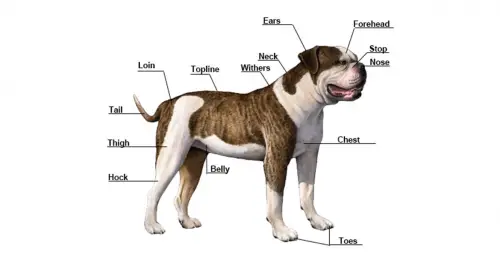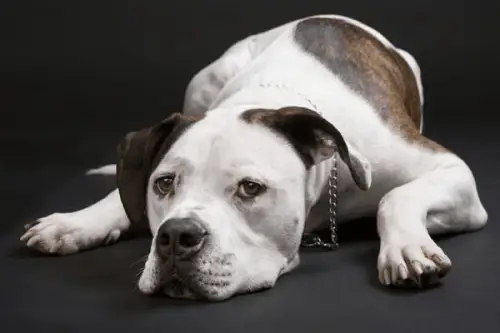The American Bulldog’s near extinction by the end of World War II led to the rise of two distinct bulldog breeds: the Johnson and the Scott American Bulldog. While the two may bear similarities, they possess distinct characteristics that appeal to different dog breeders.
Summary Table
| Johnson American Bulldog | Scott American Bulldog |
| Bred by John D. Johnson | Bred by Alan Scott |
| A crossbreed between the old Johnson breed and a northern English bulldog | A crossbreed between the early Johnson American Bulldog and non-Johnson bulldogs |
| Also called the “classic” or the “bully” type | Also called the “standard” or “performance” type |
| Stands at around 23 to 27 inches at the shoulder | Stands at around 22 to 27 inches at the shoulder |
| Resembles the English Bulldog | Resembles the American Pit Bull Terrier |
| Distinct for its wide chest, boxy head, and undershot bite | Distinct for its reverse scissors bite, slightly dropped jaws, and narrow muzzle and head |
| Less energetic | More energetic |
Descriptions

Distinct for its boxy head, the Johnson American Bulldog, popularly known as the “classic” American Bulldog, is a large, wide-chested bulldog breed developed by John D. Johnson during World War II.
These dogs are heavy-set and strongly resemble English bulldogs with their wide chests and boxy heads. The dogs come in various colors, including black, brown, and red. The dogs are very large and extremely powerful. They are best in single-pet homes as these dogs can be very territorial toward other dogs, cats, and other pets.

The Scott American Bulldog, on the other hand, is called the “standard” American Bulldog. It was bred by Alan Scott by the end of World War II, and it bears a strong resemblance to the American Pit Bull Terrier.
Scott American bulldogs are muscular but sleek. These dogs are more agile than the Johnson American bulldogs. They also stand a bit shorter. The dogs’ coat color is pure white, though they are different than pure white Pitbulls.
Johnson vs Scott American Bulldog
Since they were bred from different lineages, it is not difficult to tell the difference between the Johnson and the Scott American Bulldog.
Breeders
By the end of World War II, John D. Johnson and his father saved the American Bulldog from near extinction by looking for ideal breeding specimens from the south. As the Johnson Bulldog breed slowly became established, Alan Scott joined Johnson to further revive the breed.
Later on, as American Bulldog breeding practices progressed, Alan Scott developed a breed distinct from Johnson’s, which consequently led to the development of two different breeds: the Johnson and the Scott American Bulldog.
Breed Lineage
The Scott American Bulldog is a crossbreed between the early Johnson American Bulldog and non-Johnson bulldogs that originated from Southern farms. The later and more established version of the Johnson American Bulldog, on the other hand, is a cross between the old Johnson breed from the south and a northern English bulldog.
Types
The Johnson American Bulldog is also called the “classic” or the “bully” type. Meanwhile, the Scott American Bulldog is popularly known as the “standard” or “performance” type.
Height and Weight
Between the two, the Johnson American Bulldog is typically larger. It stands at around 23 to 27 inches at the shoulder, while the Scott American Bulldog’s height ranges between 22 to 27 inches.
The Scott American bulldog usually weighs between 80 to 100 pounds, while the larger Johnson American bulldog weighs between 90-120 pounds.
Physical Characteristics
Since the Johnson American Bulldog is a crossbreed between an early English and American breed, it greatly resembles the English Bulldog. Unlike the Scott version, it is a wide-chested dog breed distinct for its boxy head and undershot bite.
Also, according to breeding standards, the Johnson American bulldog’s lower teeth should not appear when the mouth is closed.
The Scott American Bulldog, by contrast, has a narrow muzzle and head.
It bears similarities to the American Pit Bull Terrier and it has slightly dropped jaws. It is unique for its “reverse scissors bite,” where the lower and upper incisors meet at the edges instead of overlapping when the mouth is closed.
Activity Level
The Scott American Bulldog, which is the “performance” bulldog type, is athletic in build. As compared to the Johnson bulldog, its smaller frame and lighter weight enables it to engage in more physical activities, making it the ideal companion for dog owners with an active lifestyle.
The Scott American bulldog need at least 2 or more hours of exercise a day.
On the other hand, the Johnson American bulldog isn’t as energetic and requires about 1 hour of daily exercise.
Training
The Johnson American bulldog is known for being a loyal dog. These dogs do best with pet parents who have a firm hand and can be patient working with this dog breed. These dogs are very good at listening to cues and adapting to new commands.
Scott American bulldogs are highly energetic and do best with pet parents who are patient and firm. The dogs are eager to please and easily learn new cues.
Both dog breeds require plenty of socialization, which teaches the dogs how to behave in different situations with other humans, dogs, and pets. The socialization process also makes the dogs more confident, so they don’t become fearful and possibly aggressive in new situations.





